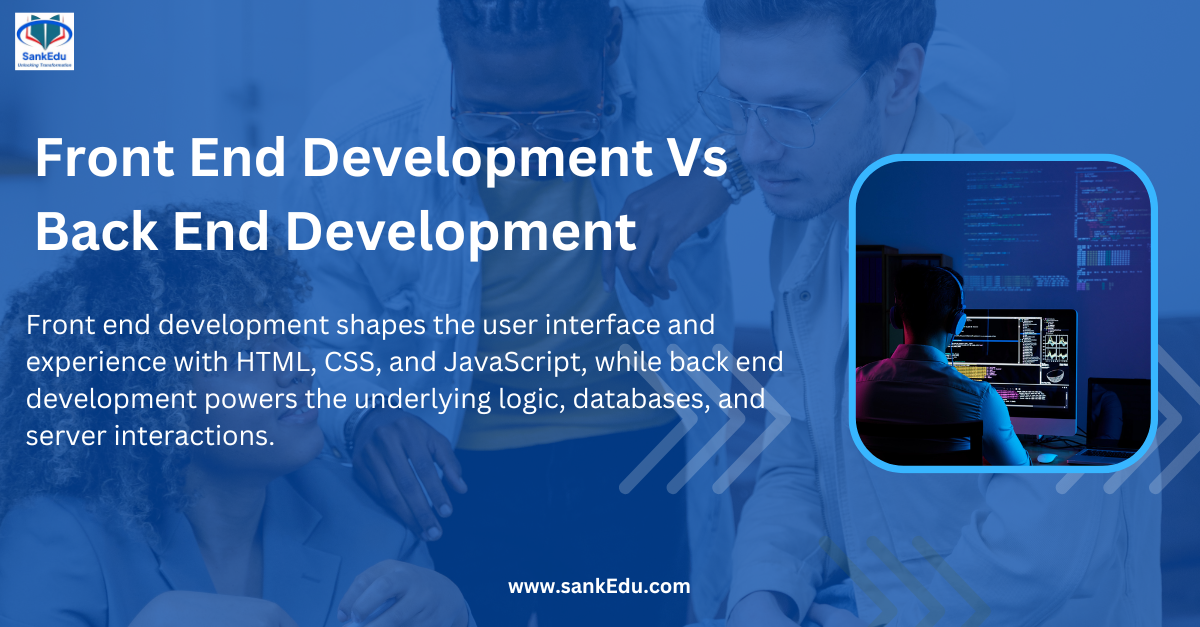
Front End vs. Back End Development
The back end and Front End are crucial for Full Stack Development. The front end focuses on user experience, while the back focuses on performance. Let us compare and see the difference between the two.
Front End Development (Client-Side)
Front-end development, also known as client-side development, deals with creating the user interface and experience that users interact with directly in their browsers. This involves using HTML, CSS, and JavaScript to build and style websites and applications. Here’s what you need to know about front-end development:
Key Responsibilities
* Designing and implementing visually appealing layouts and interfaces
* Ensuring cross-browser compatibility and optimizing performance
* Implementing interactive features such as forms, animations, and scroll effects
* Creating reusable UI components and following design systems
* Collaborating with designers, UX researchers, and product managers
Core Technologies
HTML
HTML is the foundation of any website and provides structure to the content on the page. It consists of various tags used to define elements like headings, paragraphs, lists, links, images, tables, and more.
CSS
CSS styles the visual appearance of HTML elements by controlling properties like color, font size, spacing, positioning, and transitions. With modern tools like SASS, LESS, and PostCSS, developers can create cleaner codebases and implement advanced styling techniques.
JavaScript
JavaScript enables dynamic functionality and interaction within a browser. Developers use it to manipulate DOM elements, fetch data from servers, validate form inputs, and much more. Libraries and frameworks like React, Angular, and Vue.js help streamline complex tasks and improve productivity.
Back End Development (Server-Side)
Back-end development, also referred to as server-side development, focuses on building the logic behind websites and applications. This includes managing databases, handling requests and responses between clients and servers, and ensuring security measures are in place. Let’s explore key aspects of back-end development:
Key Responsibilities
* Building APIs and integrating them into frontend applications
* Managing databases using SQL or NoSQL solutions
* Handling authentication and authorization processes
* Optimizing server response times and reducing latency
* Debugging issues related to server configurations and database management
* Collaborating with other developers, project managers, and stakeholders
Core Technologies
Programming languages
Various programming languages power back-end development, including Python, Ruby, PHP, Node.js, Java, and C#. Each language has its strengths and weaknesses; choosing one depends on your preferences and specific job requirements.
Web Frameworks & Servers
Web frameworks simplify back-end development by providing pre-built modules, libraries, and conventions. Examples include Django (Python), Rails (Ruby), Laravel (PHP), Express (Node.js), Spring Boot (Java), and ASP.NET MVC (C#). Additionally, understanding how servers work is essential when dealing with HTTP requests and responses. Popular options include Apache, Nginx, Microsoft IIS, and Google App Engine.
Databases
Databases store structured information needed by applications. Common choices include relational databases like MySQL, PostgreSQL, Oracle, and MS SQL Server, along with non-relational alternatives such as MongoDB, Cassandra, and Redis. Familiarity with both types allows flexibility depending on project needs.
Conclusion
Both front-end and back-end development offer rewarding career paths for students interested in web technology. While the front end concentrates on user experiences through HTML, CSS, and JavaScript, the back end delves deeper into logic implementation via various programming languages, frameworks, and databases. By exploring these areas further, you can determine which avenue best suits your skills and interests.




0 responses on "Front End vs Back End Development"